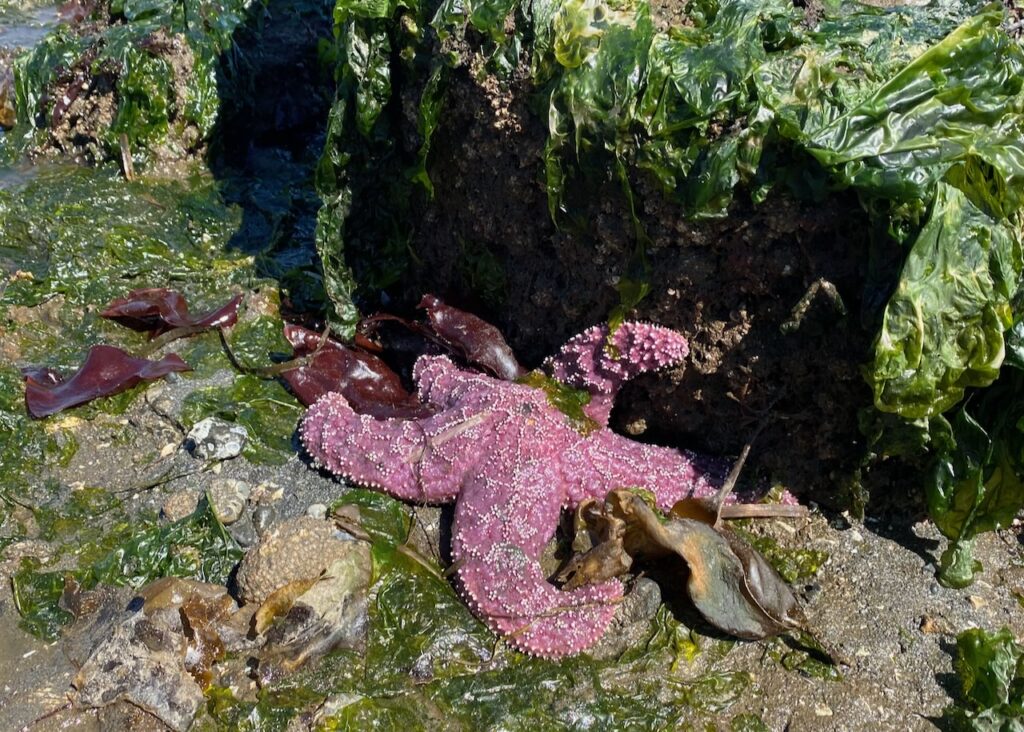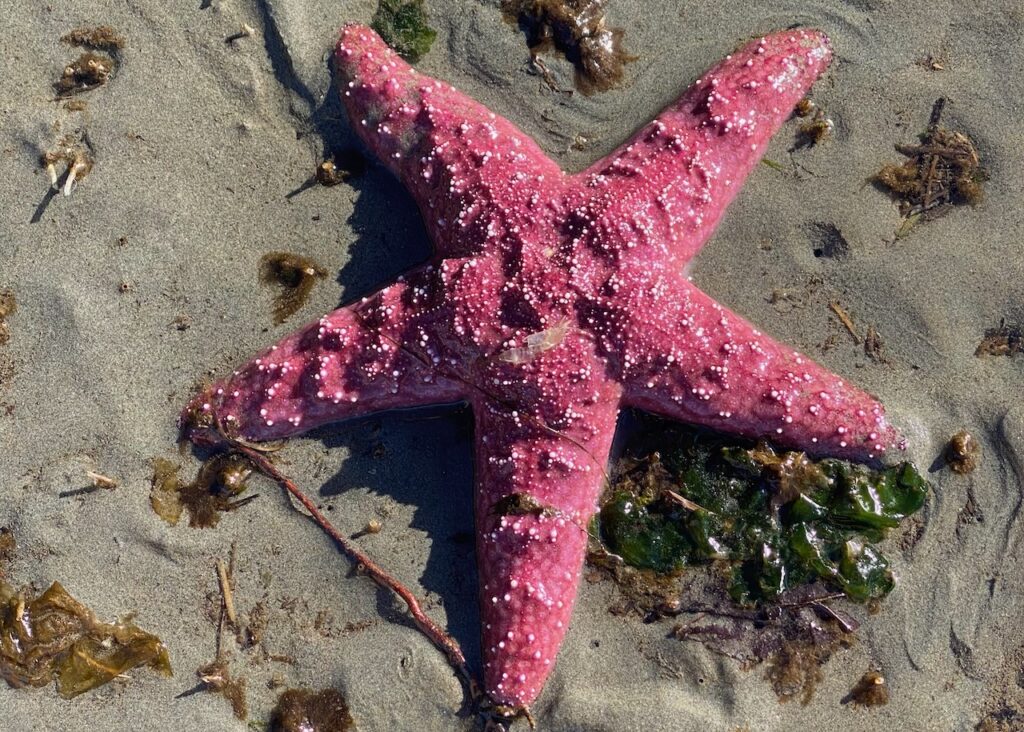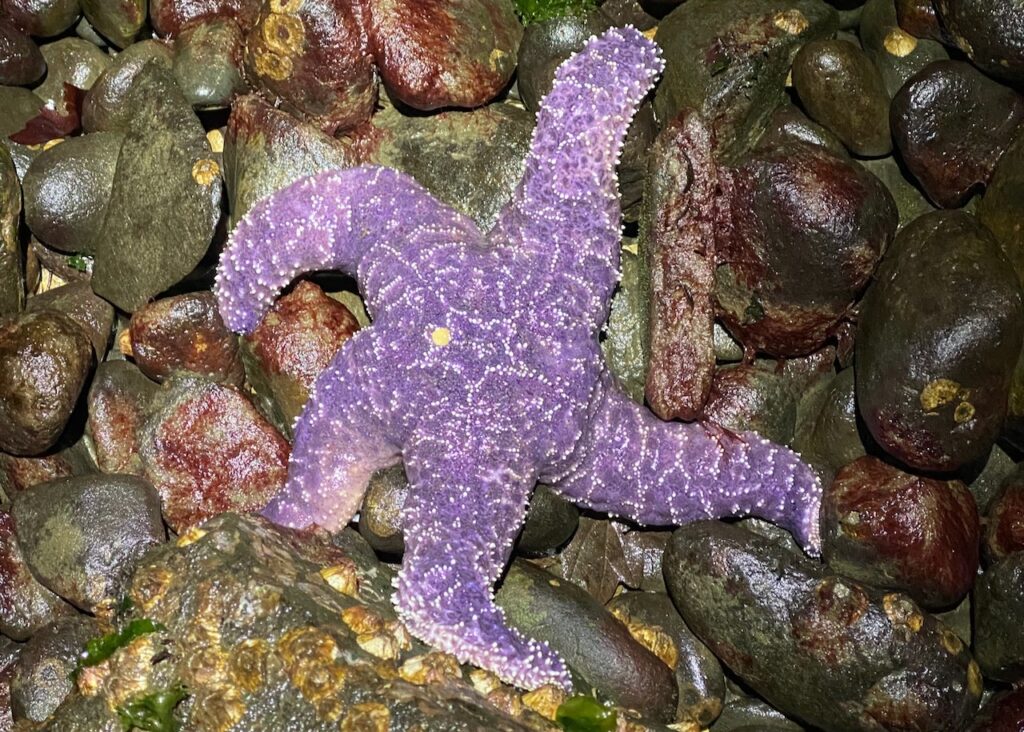Take a Closer Look: Ochre Sea Star
The ochre sea star (pisaster ochraceus) is one of the most fascinating and iconic creatures inhabiting the Salish Sea. Renowned for its vibrant colors and pivotal role in marine ecosystems, this remarkable echinoderm draws the attention of marine biologists, divers, and nature enthusiasts alike. Its striking appearance and ecological significance make it quite a unique spectacle of the Salish Sea.
A Visual Delight
The ochre sea star is instantly recognizable due to its bright, diverse coloration. Depending on its environment and genetic factors, it can be found in hues ranging from vivid oranges and reds to deep purples and pinks. This coloration helps the sea star blend into its rocky, tide-pool habitat, where it clings to rocks or crevices in the intertidal zone.
The sea star’s body is covered with small, bumpy structures called tubercles, and its arms are lined with tube feet used for movement and feeding. These adaptations allow it to navigate and cling to the rocky substrates in varying tidal shifts and sea conditions. Each sea star typically has five arms, though some individuals can have more, a trait that adds to their distinctive appearance.
Ecological Importance
Ochre sea stars play a crucial role in the marine ecosystems of the Salish Sea. As a keystone species, they have a disproportionate impact on their environment relative to their abundance. Their most significant role is their predation on barnacles and mussels. By feeding on these bivalves, ochre sea stars help maintain the balance of intertidal communities.
- Predation Dynamics: Ochre sea stars are voracious predators. They use their tube feet to pry open the shells of barnacles and mussels, which it then consumes by everting its stomach out of its mouth and into the shell. Without the predation pressure from ochre sea stars, barnacle and mussel populations could become excessively dense, outcompeting other species and dominating the ecosystem.
- Habitat Formation: By controlling the population of these sessile organisms, ochre sea stars contribute to the formation of diverse habitats. Their predation allows for the coexistence of various species in the intertidal zone, supporting an environment that is rich with biodiversity.
Reproduction and Lifespan
Ochre sea stars have an intriguing and adaptable reproductive strategy. They can reproduce both sexually and asexually. In sexual reproduction, females release up to 40 million eggs which are fertilized externally by sperm released by the males into the water. Larvae then drift with the currents before settling onto the seafloor and metamorphosing into juvenile sea stars. This reproductive strategy allows for genetic diversity and colonization of new areas.
Asexual reproduction occurs through a process known as fragmentation. If an ochre sea star loses an arm, it can regenerate the lost limb, and in some cases, a new individual can grow from a severed arm. This ability to regenerate not only helps in recovery from injury but also aids in population resilience.
In terms of lifespan, ochre sea stars can live up to 20 years in the wild. Their only predators in the Salish Sea are sea otters and glaucous-winged gulls. Adaptability is what allows each individual to thrive within their intertidal habitats.
Sea Star Wasting Disease (SSWD)
Despite their adaptability, ochre sea stars face several threats that can impact their populations. One of the most significant challenges in recent years has been the outbreak of sea star wasting disease, a condition that has caused dramatic declines in sea star populations along the Pacific Coast, including the Salish Sea.
This disease is characterized by lesions, loss of arm functionality, and ultimately, the disintegration of the sea star’s body. Researchers are still investigating the causes of this disease, which may involve viral pathogens or bacterial infections, as well as environmental stressors. The disease has had devastating effects on sea star populations, raising concerns about the health of marine ecosystems.
Conservation Efforts
Efforts to conserve ochre sea stars and their habitats are ongoing. Marine researchers and conservationists are working to better understand sea star wasting disease and its impacts. Monitoring programs help track population trends and the health of individuals, providing valuable data for conservation strategies.
- Protecting Habitats: Preserving the natural habitats of ochre sea stars is essential for their survival. Marine protected areas and regulations that limit human activities in sensitive intertidal zones help reduce additional stressors on these ecosystems. In just the San Juan Archipelago, there are over 80 islands that are protected as National Wildlife Refuge!
- Public Awareness: Educating the public about the importance of ochre sea stars and the threats they face can foster support for conservation efforts. By promoting responsible recreational practices and encouraging citizen science projects, individuals can contribute to the protection and study of these remarkable sea stars.
Experiencing the Ochre Sea Star
Due to their decline since sea star wasting disease began noticeably affecting their population in 2013, sea stars had become a very rare sighting in the Salish Sea. However, on recent tours this season, we have looked closely at some of the steep rock faces and National Wildlife Refuge sites and we spotted numerous sea stars right along the tidal line. These experiences are so incredible both for the beautiful surprise of the ochre sea star once you take that closer look, and for the hopeful notion that these resilient creatures are once again adapting and making a recovery.

Photo Credit: Brooke Casanova, Naturalist at Blue Kingdom Tours



